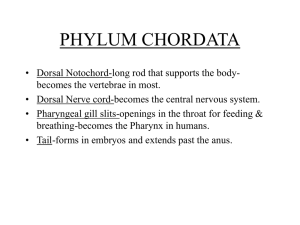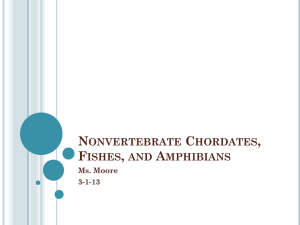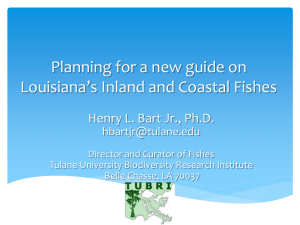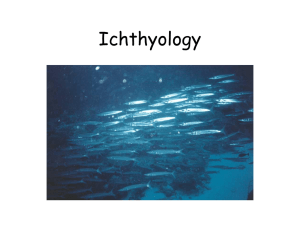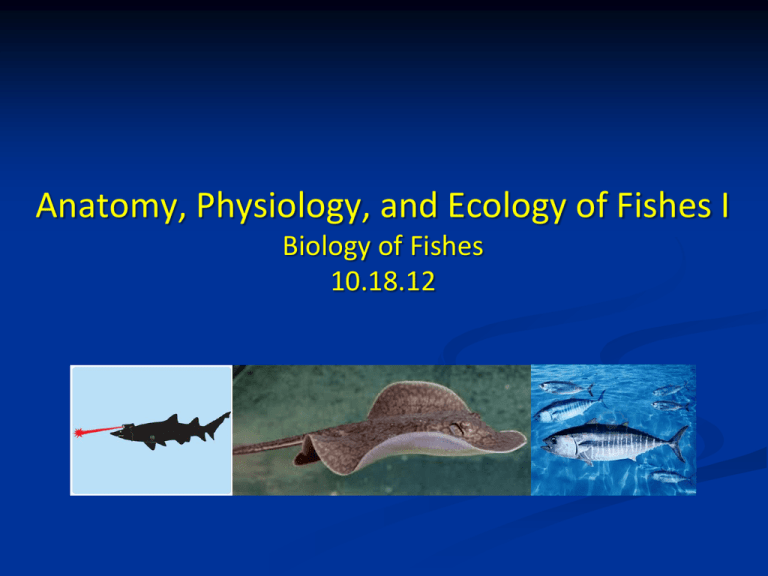
Anatomy, Physiology, and Ecology of Fishes I
Biology of Fishes
10.18.12
Overview
Exam I – Return & Review next week
Presentations & Other Assignments
Introduction to Anatomy, Physiology, and Ecology of Fishes
Anatomy, Physiology, and Ecology
Buoyancy and Locomotion
Swimming
Feeding Mechanisms
Buoyancy and Locomotion
Movement in water
Water ~800x denser than air
High density provides upward force – force buoyancy
Buoyancy – major force supporting a fish
Typical mean density of a fish carcass = 1075 kg/m3
Density of freshwater = 1000 kg/m3
Density of saltwater = 1025 kg/m3
Buoyancy and Locomotion
Weight of fish slightly greater than buoyancy force – fish must
produce an upward force or life force that overcomes the
downward pull of gravity not compensated for by buoyancy
of water
Mechanisms for generating lift
Hydrodynamic lift
Hydrostatic lift
Buoyancy and Locomotion
Hydrodynamic lift
Achieved using pectoral fins like airplane wings – generate lift as fish
swims; thrust applied via caudal fin
Most common method for supporting weight of fish in water
Also used by fishes that regulate buoyancy in other ways
Costs increase as speed decreases – primarily due to increases in drag
Examples
Sharks, tunas, mackerels (fast-swimming teleosts)
Hydrodynamic Lift
Buoyancy and Locomotion
Hydrostatic lift
Achieved by storing light or low-density materials in the body – same
mechanism as in submarines, hot air balloons, blimps
These materials include gas, lipids, and low-density fluids
Gas
Contained within the swim bladder – gas-filled sack just under spinal
column
Recall characteristic of bony fishes is presence of lungs
Lung in primitive actinopterygians
evolved into swim bladder
Hydrostatic Lift
Gas – contained in the swim bladder
Physostomous – bladder-gut connection – can gulp or burp air
(primitive condition)
Physoclistous – bladder is sealed – must secrete into or diffuse gas out
(Paracanthopterygii and Acanthopterygii)
Gas provides greatest amount of hydrostatic life per unit
volume, but presents a few problems
Unstable in roll – fish can easily tip side to side
Gas changes volume with pressure; pressure increases with depth (1
atm pressure for every 10 m depth). Fish must continuously add or
remove gas to remain neutrally buoyant if fish changes depths.
Doesn’t respond quickly to changes in position
Gas Bladder
Most fishes have gas/swim bladders, but some have lost them
in favor of other strategies – benthic life, lipids, low-density
fluids.
Hydrostatic Lift
Lipid (fats, oils, related molecules)
Found in livers of sharks and in the swim bladder wall,
skeleton, dermis, and muscle of other fishes
Most common in deep water fishes that live near the
bottom; also mid water fishes that make large vertical
migrations
Hydrostatic Lift
Low-density fluids
Water content of the fish is increased, bones are reduced,
decreases the density of body fluids and tissues
Only possible for marine fishes
Found in deep water fishes
Buoyancy and Locomotion
Trade-offs of various buoyancy mechanisms
Swimming speed
Hydrodynamic lift is more economical at higher swimming speeds
– cost of drag increases at low speeds, also harder to steer
(maintain position) at slow speeds
Hydrostatic lift is more economical at slow swimming speeds
Gas is cheaper than lipids
Depth
Gas becomes expensive at large depths – high pressure makes it
costly to fill, difficult to prevent diffusion into blood
Exceptions to trends – adaptations to specific habitats
Sculpins, darters, etc.
Swimming
Recall density of fish is close to density of water –
therefore fish do not have to use their skeletons and
muscles to support themselves (in contrast to
terrestrial organisms).
As a result, all fins and the body can be used for
locomotion.
To swim, fish must generate thrust and overcome
sources of resistance (drag, inertia).
Swimming
Types of swimming (6 primary forms)
Anguilliform locomotion
Subcarangiform locomotion
Carangiform locomotion
Thunniform locomotion
Ostraciiform locomotion
Median or paired fins
Swimming
Anguilliform Locomotion – “eel like”
Successive waves of muscle contraction passed backward on
alternate sides of body – throws body into series of S-shaped
curves
Amplitude increases toward tail
Body wave pushes mass of water backward – inertia of water
Nearly all of body participates in undulatory, side-to-side motion
Inefficient mode of swimming – body is long, most of body
(especially anterior) participates. Tail wags the head, therefore
high drag
Swimming
Anguilliform Locomotion – “eel like”
Considered primitive mode of swimming – seen in hagfish,
lamprey, many sharks
Also seen in some more advanced groups such as eels
Mode also used by many larval fishes – flexible skeleton is poorly
developed, other muscles and fins aren’t yet available for use
Swimming
Most fishes do not swim using anguilliform locomotion – most are “tail
waggers”
Instead of using most of the body to push against water for forward
propulsion, most fishes rely on a much smaller portion
If smaller portion of body undulates, side-to-side movement of head is
reduced
Reduction of side-to-side movement also accomplished by tapering of the
body towards tail; large forward body mass increases inertia, making sideto-side movement difficult
Evolutionary trend away from anguilliform, instead towards more caudal
type propulsion found in most bony fishes
Swimming
Swimming
Subcarangiform Locomotion
Two-thirds to one-half of the body is involved in producing the
propulsive wave responsible for forward motion
Side-to-side movement of head greatly reduced compared to
anguilliform
Fish using this method typically have large flexible caudal fins
Most of swimming is accomplished by the waves passing down the
body
Caudal fin probably evolved for use in fast turning, hovering, and
fast starts
Examples: trout, salmon, minnows, cods
Swimming
Carangiform Locomotion
Side-to-side undulations are confined to the last third of the body
Fish using this method typically have stiff caudal fins that are
deeply forked with elongated upper and lower lobes
Fin design is easier to move through the water (less drag) but still
generates great force
Two major evolutionary developments to counteract side-to-side
movement of the head:
1 – trend towards deeper body with more weight concentrated towards head
2 – caudal peduncle is greatly reduced
Examples: clupeids, mackerels, jacks
Swimming
Thunniform Locomotion
Carangiform locomotion developed to the extreme
Represents the end-point in evolutionary trend toward greater
speed in underwater locomotion among fishes – burst swimming
speeds over 40 mph and cruising speeds ~10 mph
Very little of the body is involved in producing forward movement
Thrust generated almost entirely by tall, stiff, and deeply forked
caudal fin – easy to move, very powerful
Drag is greatly reduced by extremely narrow caudal peduncle
Swimming
Ostraciiform Locomotion
Only seen in those fishes that are unable to move body side to side
All propulsion comes from “wagging the tail”
Slow-moving fishes, not streamlined
Typically bodies of these fishes are encased in armor
Example: boxfishes
Swimming
Median or Paired fins Locomotion
Wide variety of fishes that typically swim without using their body
or caudal fin
These fishes use either their median (anal and/or dorsal) or paired
fins (pectoral) to move
Generally tend to be slow-moving fishes
Continuum of those that use undulation to those that use
oscillation
Median fin undulation
Paired fin undulation
Intermediate
Oscillation
Median or Paired fins locomotion
Median fin undulation (bowfin, electric fishes)
Paired fin undulation (rays, skates)
Intermediate (triggerfishes, porcupine fishes)
Oscillation (puffers)
Highly maneuverable; exploit complex habitats (e.g. coral reefs, dense
vegetation)
Most can also use caudal fin for propulsion
Swimming
Important considerations in fish locomotion
Many fishes have a specialized form of swimming
Specialization for 1 function usually involves a tradeoff in another
function
Tunas are specialized for high-speed cruising – great distances at
high speed, but not very maneuverable and poor swimmers at low
speeds
Cichlids and reef fishes are specialized for high maneuverability,
but lower speed – deep bodies, high dorsal/anal fins, large paired
fins allow for precise movements in complex environments
Pikes are specialized for accelerating – large caudal fin with
dorsal/anal fins set back on body
Swimming
Important considerations in fish locomotion
We can identify some fishes that are specialized for one trait,
however, most fishes use a variety of modes of swimming and are
locomotor generalists as opposed to locomotor specialists
Most fishes must cruise to get from place to place, accelerate to
eat and avoid being eaten.
Largemouth bass can raise dorsal/anal fins to gain thrust in a “fast
start” attack, and can depress fins to reduce drag while chasing
prey. Can also raise dorsal/anal fins to aid in maneuvering.
Not all fishes fit neatly into these categories. These specializations
are likely related to how fish feed…

